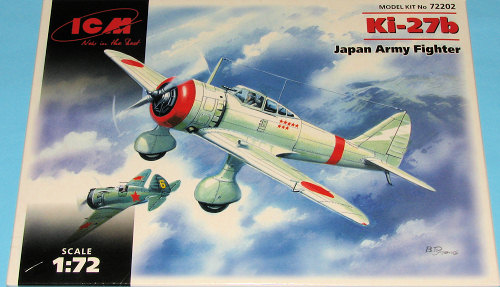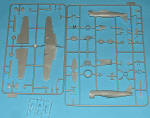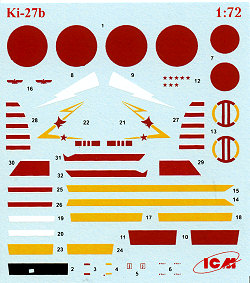
ICM 1/72 Ki-27b 'Nate'
| KIT: | ICM 1/72 Ki-27b 'Nate' |
| KIT #: | 72202 |
| PRICE: | $15.95 MSRP |
| DECALS: | Four options |
| REVIEWER: | Scott Van Aken |
| NOTES: |

| HISTORY |
The Ki-27 was the army's main fighter until the start of World War II. In the 1939 Battle of Halhin Gol against USSR in Mongolia, the Ki-27 faced I-15 biplanes and I-16 monoplanes, and dominated them with its maneuverability, downing a total of 1,252 enemy aircraft. The Ki-27's high turn performance caused the Army to focus almost exclusively on maneuverability, a decision which came back to haunt them later as it handicapped the development of more heavily armed and faster fighters. The Ki-27 served until the beginning of World War II in the Pacific, escorting bombers attacking Singapore. After it was replaced by the Ki-43, the Ki-27 continuing to serve as a trainer, was used in 'back water' areas, and for home defense. It was also exported for use with Manchukuo and Thai armed forces, seeing combat with both. In Thai service, the Ki-27 reportedly damaged a P-51 Mustang and shot down one P-38 Lightning. Near the end of World War II, a few Ki-27 were equipped with up to 500 kg (1,100 lb) of explosives for Kamikaze duty.
In spite of its excellent turning performance, in combat the Ki-27 suffered from lack of armor protection for the pilot and absence of self-sealing or fire suppression in the fuel tanks. In addition, the airframe could not handle the stress of high speeds and Soviet pilots routinely escaped Ki-27 attacks in a dive. The armament of two rifle-caliber machine guns was weak. Many of these planes were shot down by the P-40s of the AVG. The main difference between the Ki-27a and Ki-27b was the latter's addition of bomb racks and the provision for under wing fuel tanks.
Thanks to http://en.wikipedia.org for most of the background info.
| THE KIT |
 ICM
joins RS Models and Hasegawa/Mania in releasing an injected plas
ICM
joins RS Models and Hasegawa/Mania in releasing an injected plas tic
1/72 Ki-27.The kit is contained on two light grey and one clear sprue. Overall
detail is actually quite good with engraved panel lines and finely done rivet
detailing. I did note a bit of flash on one upper wing tip and on the prop tips.
The kit provides a number of interesting options regarding the landing gear and
the canopy. There is also a separate motor mount for the engine. It appears that
one can do the kit without spats and with the lower rudder housing removed.
tic
1/72 Ki-27.The kit is contained on two light grey and one clear sprue. Overall
detail is actually quite good with engraved panel lines and finely done rivet
detailing. I did note a bit of flash on one upper wing tip and on the prop tips.
The kit provides a number of interesting options regarding the landing gear and
the canopy. There is also a separate motor mount for the engine. It appears that
one can do the kit without spats and with the lower rudder housing removed.
I'm using all these generalities as my kit did not come with building instructions, only the markings placement guide and two copies of the 'do not eat this plastic' warning sheet. I'm going to e-mail ICM and see if this gets me a copy of the instructions.
Markings are nicely done, matte, very complete, and for four aircraft. First is the box art aircraft of Capt. Shimada, 11 Sentai during June of 1939. Next, in a similar camo scheme is Sgt. Takuwa's plane from the 64 Sentai during August 1939. From 1944 is a white wing and fuselage banded plane of the 244 Sentai on home defense duties. The lone disruptive camo plane is from the 24 Sentai in China during December 1941. It is the latter plane that I modeled using the RS kit last year.
| CONCLUSIONS |
If I can judge this one by other ICM kits, it will be a superb alternate to the previously mentioned kits. Though perhaps not as easy a build as the Hasegawa/Mania version, it is easily as detailed as the RS kit, which was a bear to construct. I'm sure that many JAAF fans will be pleased with this one.
My thanks to www.dragonmodelsusa.com for the review kit. You can find this one at your local hobby shop. If they don't have one ask them to order it for you.
If you would like your product reviewed fairly and quickly, please contact me or see other details in the Note to Contributors.